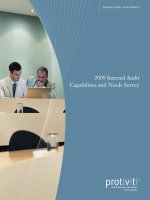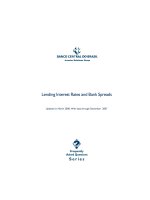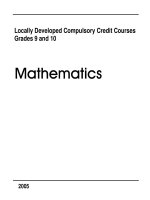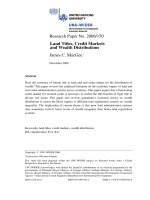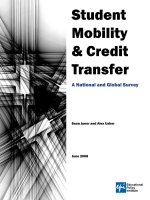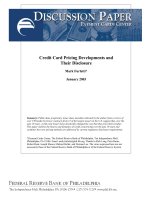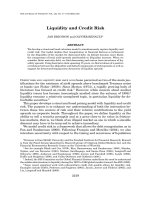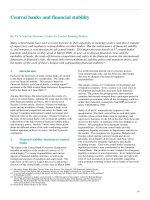Stolen Asset Recovery (StAR) Initiative: Challenges, Opportunities, and Action Plan pot
Bạn đang xem bản rút gọn của tài liệu. Xem và tải ngay bản đầy đủ của tài liệu tại đây (2.56 MB, 56 trang )
Stolen Asset Recovery (StAR) Initiative:
Challenges, Opportunities, and Action Plan
By signaling to corrupt leaders that there will be no safe haven for stolen
assets, StAR would constitute a formidable deterrent to corruption in
developing countries. StAR would also serve to bring in the other side of
the corruption equation, as stolen assets tend to be stashed in developed
country financial centers.
Stolen Asset Recovery (StAR) Initiative:
Challenges, Opportunities, and Action Plan
June 2007
© 2007 The International Bank for Reconstruction and Development/The World Bank
1818 H Street, NW
Washington, DC 20433
Telephone 202-473-1000
Internet www.worldbank.org
E-mail
All rights reserved.
The findings, interpretations, and conclusions expressed herein are those of the author(s) and do
not necessarily reflect the views of the Board of Executive Directors of the World Bank or the
governments they represent.
The World Bank does not guarantee the accuracy of the data included in this work. The boundaries,
colors, denominations, and other information shown on any map in this work do not imply any
judgment on the part of the World Bank concerning the legal status of any territory or the endorse-
ment or acceptance of such boundaries.
Rights and Permissions
The material in this work is copyrighted. Copying and/or transmitting portions or all of this work
without permission may be a violation of applicable law. The World Bank encourages dissemination of
its work and will normally grant permission promptly.
For permission to photocopy or reprint any part of this work, please send a request with complete
information to the Copyright Clearance Center, Inc., 222 Rosewood Drive, Danvers, MA 01923, USA,
telephone 978-750-8400, fax 978-750-4470, www.copyright.com.
All other queries on rights and licenses, including subsidiary rights, should be addressed to the Office of
the Publisher, World Bank, 1818 H Street NW, Washington, DC 20433, USA, fax 202-522-2422, e-mail
Table of Contents
Acknowledgments ………………………………………….……………………………………….iv
Executive Summary 1
1. Why StAR? Why Now? 5
2. Estimates of the Size of the Problem and Potential Benefits from Tackling High-level Corruption 8
2.1 Global Estimates 9
2.2 Country-level Estimates 10
2.3 The Development Impact of StAR 11
3. How Stolen Money is Hidden 13
4. Legal Framework: The UN Convention Against Corruption (UNCAC) 15
5. Findings from Country Case Studies 18
5.1 Synopsis of Country Case Studies 18
5.1.a Nigeria 18
5.1.b Peru 19
5.1.c The Philippines 20
5.2 Asset Theft Facilitated by Lack of Transparency and Low Public Accountability 22
5.3 Domestic Political Will and International Cooperation Key to Asset Recovery 23
5.4 Monitoring Use of Recovered Assets Impeded by Weak Systems and Fungibility 24
5.5 Challenges Ahead 26
6. An Action Plan 30
6.1 Action Plan Matrix 31
6.2 UNODC-WBG Joint Program 33
6.2.a Building Global Partnerships on StAR 33
6.2.b Building Institutional Capacity and Providing Technical Assistance at the Country Level 34
6.2.c Implementation and Monitoring of UNCAC 36
Appendix A. Options to Improve Public Financial Management 38
Appendix B. What Other Agencies are Doing 41
Appendix C. Focal Point Questionnaire 45
References 47
Note: All dollar amounts are in U.S. dollars, unless otherwise indicated.
Acknowledgments
This report was prepared jointly by the United Nations Office on Drugs and Crime (UNODC) and the
World Bank. The World Bank effort was led by Brian Pinto (PRMED), with valuable contributions
from Daniel Kaufmann (WBI); Victor A. Dumas and Francis Rowe (PRMED); Theodore S.
Greenberg (FPDFI); William L. Dorotinsky and Richard Messick (PRMPS); and Scott White (LEG).
The UNODC effort was led by Francis Maertens (DPA), Dimitri Vlassis (DTA/CCS), and Stuart C.
Gilman (DO/GPAC), with valuable contributions from Rick McDonnell and Delphine Schantz
(DO/GPML) and Oliver Stolpe (DO/GPAC). The report was prepared under the overall leadership
and supervision of Dr. Ngozi Okonjo-Iweala (former Finance Minister of Nigeria) and Danny
Leipziger (PRMVP). Guidance from Juan Jose Daboub (MDD), Vikram Nehru (PRMED), Sanjay
Pradhan and Randi Ryterman (PRMPS), and Joachim von Amsburg (EACPF) is gratefully
acknowledged.
Three country case studies on Nigeria, Peru, and the Philippines were commissioned as analytical
background papers in support of the StAR Initiative. The Nigeria case study was prepared by Dr.
Ngozi Okonjo-Iweala. The Peru case study was prepared by Victor A. Dumas. The Philippines case
study was prepared by Professor Leonor Briones. For further information regarding the StAR
Initiative, please contact Randi Ryterman, Sector Manager PRMPS ().
iv Stolen Asset Recovery (StAR) Initiative:
Executive Summary
The theft of public assets from developing countries is a huge and serious problem:
• The cross-border flow of the global proceeds from criminal activities, corruption, and tax
evasion is estimated at between $1 trillion and $1.6 trillion per year.
• Corrupt money associated with bribes received by public officials from developing and transition
countries is estimated at $20 billion to $40 billion per year—a figure equivalent to 20 to 40
percent of flows of official development assistance (ODA).
These estimates, while imprecise, give an idea of the large magnitude of the problem and the
need for concerted action to address it. Indeed, the coming into force in 2005 of the landmark
UN Convention Against Corruption (UNCAC), which devotes a chapter to asset recovery, signals
the growing global consensus for urgent action.
Assets stolen by corrupt leaders at the country-level are frequently of staggering magnitude. The
true cost of corruption far exceeds the value of assets stolen by the leaders of countries. This would
include the degradation of public institutions, especially those involved in public financial management
and financial sector governance, the weakening if not destruction of the private investment climate,
and the corruption of social service delivery mechanisms for basic health and education programs,
with a particularly adverse impact on the poor. This “collateral damage” in terms of foregone growth
and poverty alleviation will be proportional to the duration of the tenure of the corrupt leader.
While the traditional focus of the international development community has been on addressing
corruption and weak governance within the developing countries themselves, this approach
ignores the “other side of the equation”: stolen assets are often hidden in the financial centers
of developed countries; bribes to public officials from developing countries often originate from
multinational corporations; and the intermediary services provided by lawyers, accountants, and
company formation agents, which could be used to launder or hide the proceeds of asset theft
by developing country rulers, are often located in developed country financial centers.
Addressing the problem of stolen assets is an immense challenge. Even though countries as
diverse as Nigeria, Peru, and the Philippines have enjoyed some success in asset recovery, the
process has been time-consuming and costly.
• Generalizing from the experience of these countries, developing countries are likely to
encounter serious obstacles in recovering stolen assets.
• Even where the political will to pursue stolen assets exists, limited legal, investigative, and judicial
capacity and inadequate financial resources could hamper the process.
• Jurisdictions where stolen assets are hidden, often developed countries, may not be responsive to
requests for legal assistance.
Challenges, Opportunities, and Action Plan 1
The Stolen Asset Recovery (StAR) initiative is being launched jointly by the UN Office on
Drugs and Crime (UNODC) and the World Bank Group (WBG) to respond to this problem. Given
the nature of the problem, success will depend critically upon forging and strengthening partner-
ships among developed and developing countries, as well as other bilateral and multilateral agencies
with an interest in the problem.
The development pay-off to the StAR initiative is expected to be significant. Even a portion
of recovered assets could provide much-needed funding for social programs or badly needed
infrastructure. Every $100 million recovered could fund full immunizations for 4 million children or
provide water connections for some 250,000 households. The total benefit would far exceed that
associated with the asset restitution itself, assuming that the released funds are well spent.
First, a StAR program that transmits the signal that there is no safe haven for stolen assets will
embody a powerful deterrent effect. Second, over the long run, one would expect significant and
lasting benefits, assuming the asset recovery effort is accompanied by institutional reform and
better governance. Indeed, without improvements in governance, a StAR initiative will not have
lasting benefits.
The UNODC-WBG StAR initiative is an integral part of the World Bank Group’s recently
approved Governance and Anti-Corruption Strategy, which recognizes the need to help develop-
ing countries recover stolen assets. The international legal framework underpinning StAR is
provided by the UN Convention Against Corruption, the first global anticorruption agreement,
which entered into force in December 2005. UNODC is both the custodian and the lead agency sup-
porting the implementation of UNCAC, as well as the Secretariat to the Conference of State Parties.
The Action Plan presented in this report responds to feedback received from consultations
with developed and developing countries, as well as lessons from the experience of Nigeria,
Peru, and the Philippines:
• Theft of public assets is facilitated by a lack of transparency and public accountability.
• Developing countries need to strengthen their legal, financial, and public financial manage-
ment systems.
• Even when political will exists in victim countries, legal differences across jurisdictions or the
unwillingness of developed countries to help can derail asset recovery.
A fundamental premise of the Action Plan is that a successful effort on stolen asset recovery
calls for global action:
• Political will and legal reform are also needed in developed countries, not just in developing
countries. Both sets of countries need to ratify and implement the UN Convention Against
Corruption (UNCAC).
• Time is of the essence. Prolonging the process of asset recovery will take a toll on the credibility
of the victim country. A prompt response is needed from countries where stolen assets are hidden.
• Global cooperation is needed to ensure that new financial havens do not replace the existing
ones and developing countries receive the legal support they need.
2 Stolen Asset Recovery (StAR) Initiative:
Examples of proposed actions include:
• Implementation of UNCAC, including developing and strengthening partnerships with multilateral
and bilateral agencies in pursuit of this effort.
• Developing a pilot program aimed at helping countries recover the stock of stolen assets by
providing the needed legal and technical assistance. This could include help on filing a request
for mutual legal assistance and advice on experts needed. Neither the WBG nor UNODC would
get directly involved in the investigation, tracing, law enforcement, prosecution,
confiscation, and repatriation of stolen assets—activities that may be best suited for
government-to-government assistance or private sector assistance, working with the rele-
vant government authorities.
• Offering countries alternatives for monitoring recovered assets, within an overall framework
of public financial management reform, to ensure transparency and effective use of those
assets. Such monitoring would be on a voluntary basis, with the agreement of all the countries
concerned, in keeping with the fundamental principle of the return of stolen assets as embod-
ied in UNCAC.
• Building global partnerships on StAR.
At the 2007 IMF-World Bank Spring Meetings, during a side-event introducing the StAR
Initiative, representatives of developed and developing countries and multilateral development
banks expressed strong support for the Initiative. The consensus was that StAR is an idea
whose time has come and that every country or international agency must do its part to make it
succeed. Indeed, a collective global effort is essential for success and unequivocally transmitting
the signal that corruption does not pay. In this sense, StAR was described as the “missing link” in
an effective anti-corruption effort. By putting corrupt leaders on notice that stolen assets will be
traced, seized, confiscated, and returned to the victim country, StAR would constitute a formidable
deterrent to corruption. Working in close partnership with the international development community,
UNODC and the WBG hope to make a positive difference to developing countries through the
StAR Initiative.
Challenges, Opportunities, and Action Plan 3
4 Stolen Asset Recovery (StAR) Initiative:
Working in close partnership with the international development
community, the United Nations Office on Drugs and Crime and the
World Bank Group hope to make a positive difference to developing
countries through the StAR initiative.
In recent years, countries as far-flung and diverse as Nigeria, Peru, and the Philippines have enjoyed
some success in securing the repatriation of assets stolen by their corrupt former leaders. Success,
however, has been neither easy nor quick. Consider the Philippines. In 1986, the Republic of the
Philippines filed a request for mutual assistance with the Swiss authorities in connection with the
repatriation of Marcos deposits in Swiss banks. Twelve years elapsed before these deposits were
transferred to escrow accounts in the Philippine National Bank (PNB) and another six years passed
before the concerned $624 million was transferred to the Philippine Treasury. In between, several
major legal hurdles had to be crossed, including presenting evidence that the monies were the
product of embezzlement, diversion of public property, and plundering of the public treasury. Only
after the Philippine government won a ruling that the monies could be moved out of Switzerland
without a final conviction of Mrs. Marcos under article 74A of the International Mutual Assistance
on Criminal Matters Act (IMAC) was the money moved to the Philippine National Bank in 1998. It
was released to the Philippine Treasury in 2004 following a Philippine Supreme Court decision
ordering the forfeiture of the Marcos Swiss deposits in July 2003.
1
Quite apart from the hurdles faced by developing countries in asset recovery, at least three other
sets of events have shone a spotlight on the problem of assets stolen by corrupt leaders. First,
starting in 1997, several important pieces of international legislation against corruption, bribery,
and transnational organized crime have been adopted. The landmark UN Convention Against
Corruption (UNCAC), which came into force in December 2005, includes a chapter exclusively
devoted to asset recovery, attesting to the need to address this problem urgently. Second, the
9/11 terrorist attack of the United States in 2001 has intensified the campaign against the financing
of terrorism and money laundering. The main financial centers of the world, in being seen as
a safe haven for the stolen assets of corrupt leaders, criminals, and terrorists, face a higher
reputational risk today than they did 10 years ago. Third, developing countries themselves are
gearing up to recover stolen assets and use the proceeds to fund development programs and
facilitate the achievement of the Millennium Development Goals (MDGs). Consider the 2001
Nyanga Declaration on the recovery and repatriation of Africa’s wealth by the representatives of
Challenges, Opportunities, and Action Plan 5
Why StAR?
Why Now?
1.
1. Drawn from a December 12, 2006 statement by the Philippines’ Ombudsman to the first meeting of the State Parties to the UN
Convention Against Corruption (UNCAC) in Amman, Jordan.
Transparency International in 11 African countries, which explicitly refers to”…Nigeria's President
Olusegun Obasanjo's address to the UN General Assembly in September 1999 calling for the
creation of an international convention for the repatriation of Africa's wealth illicitly appropriated
and kept abroad.”
2
This support was more broadly manifested during the first session of the Ad
hoc Committee negotiating UNCAC, when developing countries from all regions decided to make
asset recovery a high priority of the Convention.
While there is clearly positive momentum and support for recovery of stolen assets, the challenges
are immense. Differences in legal systems across jurisdictions where the theft occurs and money
is laundered and parked present a formidable impediment to asset recovery. So far, countries
have largely pursued their cases on a bilateral basis and with great difficulty. And while the entering
into force of UNCAC is a big step forward, half the G-8 countries have yet to ratify it. Moreover, there
is the issue of building capacity in developing countries hoping to invoke UNCAC. The following are
likely to be impediments:
• Countries that seek the recovery of stolen assets may not have a domestic regime to deal with
money laundering and the forfeiture of stolen assets. These countries usually lack the capacity
in their criminal justice system to produce adequate and appropriate requests for international
legal assistance.
• Death, the fugitive status, and immunity of persons engaged in looting assets could impede the
process, as could the continuing political influence and power of former corrupt officials.
Even when the conditions are right for pursuing asset recovery, some developed countries may
not cooperate because they do not trust the requesting country or lack confidence in their rule
of law or for political reasons.
3
Against this background of positive momentum yet immense challenge, the World Bank Group
(WBG), in partnership with the United Nations Office of Drugs and Crime (UNODC), is launching
the Stolen Asset Recovery (StAR) initiative. The roles of these institutions will be framed by their
respective mandates: in the case of UNODC by its responsibility as the custodian of UNCAC and
Secretariat to the Conference of State Parties; and in the case of the WBG, by the recently
approved Governance and Anti-Corruption (GAC) strategy, which recognizes the need for global
action on stolen asset recovery.
4
The objective of the UNODC-WBG partnership is three-fold:
• Use both institutions’ convening power to enhance cooperation between developed and developing
countries on StAR and persuade all countries to ratify and implement UNCAC. This agenda will
be pursued in close partnership with other agencies working on related topics.
6 Stolen Asset Recovery (StAR) Initiative:
2. See />3. The term “requesting” or “sending” country in the context of stolen asset recovery typically refers to developing countries from which
assets were stolen and “sent” to developed country havens (“receiving countries”). The former then request the latter to return the
stolen assets.
4. The World Bank Group’s Board unanimously endorsed the Governance and Anti-Corruption strategy paper on March 20, 2007. See
World Bank (2007).
• Build partnerships aimed at enhancing legislative, investigative, judicial, and enforcement
capacity in developing countries to enable them to successfully recover the stock of stolen
assets kept either in the home country or secreted abroad, while deterring the new flow.
• Help concerned developing countries—when voluntarily agreed within the legal framework of
UNCAC—monitor the use of recovered assets, as was done in Nigeria (discussed in section 5).
While UNCAC is clear that recovered assets should be returned, in some cases recovery efforts
could be enhanced by voluntary agreements on monitoring to ensure that recovered assets are
used transparently for developmental purposes. The WBG’s experience with public expenditure
tracking can be put to use in helping monitor the use of recovered assets, at the election of the
country in question.
5
A StAR role for the WBG would thus be an integral part of its Governance
and Anti-Corruption (GAC) Strategy, with its focus on financial sector governance, transparent
and sound public financial management, global collective action, and the deterrence of corrup-
tion by public officials.
Challenges, Opportunities, and Action Plan 7
5. This is discussed further in section 5.
This section presents global and country-level estimates of theft by corrupt leaders. The theft of
public assets involves two key steps: stealing assets, and then laundering the proceeds—either at
home or abroad—to avoid detection and make them appear legitimate. Global estimates are
derived from estimates of sums of money laundered worldwide. Country-level estimates linked
to the names of specific rulers are obtained from Transparency International, which has compiled
the data from various sources.
6
Given the nature of the activity, accurate measurement of the amount of illegal monies involved
at either the global or country-level may not be feasible. Another source of ambiguity stems from
differing definitions of corruption and the scope of the activities included in the various estimates
of illegal monies, not all of which involve cross-border flows. Thus the theft of public assets by
corrupt leaders—the focus of this paper—which is usually referred to as grand corruption, may simply
be the tip of the iceberg. For example, the billions looted by the corrupt leader of an oil exporting
developing country, while visible and significant enough to warrant action in its own right, may be
only one part of an extensive network of corruption that infects the whole economy, creating a
pyramid of corruption. This could include public sector companies, the financial system, and petty
corruption associated with policemen and factory inspectors. These various interpretations of
the scope of corruption need to be kept in mind when reviewing estimates of the sums of money
involved in illegal activity.
Before proceeding to estimates of the sums of illegal and corrupt monies, it is worth stressing
that the true cost of corruption far exceeds the value of assets stolen by the leaders of countries.
This would include the degradation of public institutions, especially those involved in public
financial management and financial sector governance, the weakening if not destruction of the
private investment climate, and the corruption of social service delivery mechanisms for basic
8 Stolen Asset Recovery (StAR) Initiative:
Estimates of the Size of
the Problem and Potential
Benefits from Tackling
High-level Corruption
2.
6. See Transparency International’s 2004 Global Corruption Report, chapter 1, p. 13. Introduction available at
/>health and education programs with a particularly adverse impact on the poor. This “collateral
damage” in terms of growth and poverty alleviation will be proportional to the duration of the
tenure of the corrupt leader.
2.1 GLOBAL ESTIMATES
Numerous studies have attempted to estimate the sums of money being laundered worldwide.
Besides suffering from serious flaws in estimation techniques, attempts to derive complete estimates
are hampered by the fact that the volume of laundered money is not restricted to assets corruptly
acquired by country leaders. Money laundering (ML) services could also be demanded by those
evading taxes or involved in the trade of illegal arms or narcotics. The estimates available, therefore,
need to be taken as, at best, rough approximations. Several estimates provide the upper or lower
bounds, ranging from:
• 2 to 5 percent of global GDP (Camdessus 1998), which amounts to $800 billion to $2 trillion in
current U.S. dollars, as an estimate of the total funds involved in various illegal activities.
7
• $3.4 trillion as an upper bound (cited in Reuter and Truman 2004). This number is based on
estimates of the unobserved economy, which is a broad definition of illegal and legal activities
excluded from GDP in 21 OECD countries, based on Schneider and Enste (2000) and Schneider
(2002).
• $20 billion to $40 billion (2001 Nyanga Declaration). This is an estimated stock of assets
acquired by corrupt leaders of poor countries, mostly in Africa, and stashed overseas.
• $500 billion in criminal activities, $20 billion to $40 billion in corrupt money, and $500 billion
in tax evasion per year (Baker and others 2003; Baker 2005). This adds up to roughly $1 trillion,
with half coming from developing and transition economies.
• 25 percent of the GDP of African states lost to corruption every year, amounting to $148 billion
(U4 Anti-Corruption Resource Centre 2007). This estimate is likely to encompass the full range
of corrupt actions, from petty bribe-taking done by low level government officials to inflated
public procurement contracts, kickbacks, and raiding the public treasury as part of public asset
theft by political leaders.
Of the above numbers, all are annual flows, except those cited in the 2001 Nyanga Declaration
by the representatives of Transparency International in 11 African countries. It notes that $20 billion
to $40 billion “…has over the decades been illegally and corruptly acquired from some of the
world’s poorest countries, most of them in Africa, by politicians, soldiers, businesspersons and
other leaders, and kept abroad in the form of cash, stocks and bonds, real estate and other
assets.”
8
This stock figure is much lower than what one might expect, given the flow of 25 percent
of African GDP often cited as being lost in total corruption, which amounts to $148 billion per
year in current dollars.
9
Challenges, Opportunities, and Action Plan 9
7. This figure has been widely quoted in the literature; however, a documented basis for it could not be found. IMF (2001, p. 10) quotes an
FATF estimate of flows associated with drug trafficking at 2 percent of global GDP, so by assumption, 2 to 5 percent is likely to be
referring to total flows.
8.
9. However, neither a precise source nor an underlying methodology for this number could be pinned down. It appears to have become a
“fact” as a result of being repeatedly cited.
Baker (2005) presents global estimates of annual money laundering based on a “bottom up”
approach. The funds needing money laundering are divided into the three components: criminal,
including drugs, counterfeited goods and money, human trafficking, illegal arms trade, and
unrecorded oil sales; corrupt, essentially accruing to Politically Exposed Persons (PEPs), the
focus of this paper, from illegal activities like bribery, extortion, fraud, and embezzlement from
national treasury; and proceeds linked to tax evasion.
10
Baker estimates the sums involved from
these three components at a global level of between $1 and $1.6 trillion annually, with roughly
half coming from developing and transitional economies.
11
While the numbers are alarming, one should guard against cloaking them with an aura of scientific
precision in view of the weaknesses in the estimation methods used. Reuter and Truman (2004,
p. 16) acknowledge that “At best, the various estimates suggest that there is substantial potential
demand for money-laundering services, but there is little basis for concluding whether it
amounts to hundreds of billions or trillions of US dollars.” And IMF (2001, p. 12, para. 24) notes in
like vein: “Measurements based on reported crimes underestimate the amount of financial system
abuse, while estimates based on underground activity clearly exaggerate it.”
2.2 COUNTRY-LEVEL ESTIMATES
Directly relevant to this paper are estimates of the total stock of assets stolen by the corrupt
leaders of various countries, which in an individual context, are often highly significant. Table 1,
based on Transparency International (2004), focuses on 10 of the notorious cases of the past few
decades. As the TI report cautions, the political leaders shown are not necessarily the 10 most
corrupt leaders of the period under consideration and “…the estimates of funds allegedly embezzled
are extremely approximate.” Indeed, the sources cited by TI (2004) are chiefly journalistic. The
only number coming from an official country source is that for Fujimori, from the Office of the
Special State Attorney for the Montesinos/Fujimori Case, Peru.
The third column of the table gives the estimated total stock of stolen assets, lower and upper
bound, in billions of U.S. dollars, based on TI (2004). The fourth column gives average annual
nominal GDP in dollars over the period the corrupt leader ruled. The final columns convert the
stock of stolen assets into an equivalent annual flow, expressed as a percentage of average annual
GDP, giving both the lower and upper bound for the annual rate of theft.
12
According to the numbers
in table 1, Jean-Claude Duvalier allegedly stole the equivalent of 1.7 to 4.5 percent of Haitian GDP
for every year he was in power. The only other two kleptocrats to come close as a percentage of
GDP were Ferdinand Marcos and Sani Abacha.
13
10 Stolen Asset Recovery (StAR) Initiative:
10. Politically Exposed Persons (PEPs) are defined in the Glossary to the Financial Action Task Force Forty Recommendations (FATF 2003,
p. 14) as “individuals who are or have been entrusted with prominent public functions in a foreign country, for example, Heads of State
or of government, senior politicians, senior government, judicial or military officials, senior executives of state owned corporations,
important political party officials. Business relationships with family members or close associates of PEPs involve reputational risks
similar to those with PEPs themselves. The definition is not intended to cover middle ranking or more junior individuals in the foregoing
categories.” The document is available at />11. For details, see Baker (2005, pp. 165–73 and table 4.4, p. 172). Bottom-up or micro methods are also discussed in Reuter and Truman
(2004, pp. 19–23). They note that the estimates are subject to serious flaws.
12. For example, in the case of Suharto, the number of 0.6 is obtained as {[(15/31)/86.6] X 100}, where 31 is the number of years for which
Suharto ruled Indonesia.
13. The term “kleptocrat” is used to describe corrupt heads of state and other politically exposed persons (PEPs).
2.3 THE DEVELOPMENT IMPACT OF STAR
The first source of development impact or benefit from the StAR initiative would come from the asset
restitution itself, by releasing much-needed funds for development. However, this benefit will accrue
only if the recovered assets are used well, to support the attainment of the Millennium Development
Goals (MDGs) or invest in badly needed infrastructure, for example. As the country case studies in
section 5 will show, transparent and effective use of recovered assets cannot be taken for granted.
Consider these examples of the development impact that could result from restitution of stolen
assets. Table 2 contains unit cost estimates of key inputs in various health programs used by the
World Bank’s Africa Region in its operational work, as well as infrastructure projects. The cost
estimates suggest that every $100 million restituted to a developing country could fund:
• 3.3–10 million insecticide-treated bednets, which are twice as effective as regular bednets; or
• First-line treatment for over 600,000 people for one year for HIV/AIDS; or
• 50–100 million ACT treatments for malaria; or
• Full immunizations for 4 million children; or
• Approximately 250,000 water connections for households; or
• 240 kilometers of two-lane paved road.
Challenges, Opportunities, and Action Plan 11
TABLE 1. ESTIMATES OF FUNDS ALLEGEDLY EMBEZZLED FROM 9 COUNTRIES
Source: TI (2004) for first three columns; World Bank staff for the rest.
Note: The GDP calculations for Indonesia cover 1970–98, and for Zaire, 1970–97.
Political leader Country
Stolen
assets
($billion)
Average
annual
GDP
($billion)
Annual theft as
percent of average
nominal GDP
Lower
bound
Upper
bound
Mohamed Suharto (1967–98) Indonesia 15 to 35 86.6 0.6 1.3
Ferdinand Marcos (1972–86) Philippines 5 to 10 23.9 1.5 4.5
Mobutu Sese Seko (1965–97) Zaire 5 8.8 1.8 1.8
Sani Abacha (1993–98) Nigeria 2 to 5 27.1 1.5 3.7
Slobodan Milosevic (1989–2000) Serbia/Yugoslavia 1 12.7 0.7 0.7
Jean-Claude Duvalier (1971–86) Haiti 0.3 to 0.8 1.2 1.7 4.5
Alberto Fujimori (1990–2000) Peru 0.6 44.5 0.1 0.1
Pavlo Lazarenko (1996–97) Ukraine 0.114 to 0.2 46.7 0.2 0.4
Arnoldo Alemán (1997–2002) Nicaragua 0.1 3.4 0.6 0.6
Joseph Estrada (1998–2001) Philippines 0.07 to 0.08 77.6 0.04 0.04
Average % of GDP 0.9 1.8
12 Stolen Asset Recovery (StAR) Initiative:
The total benefit would far exceed that associated with the asset restitution itself, assuming that
the released funds are well spent. First, a StAR program that transmits the signal that there is
no safe haven for stolen assets will embody a powerful deterrent effect. Second, over the long
run, one would expect significant and lasting benefits, assuming the asset recovery effort is
accompanied by institutional reform.
The potential benefit from institutional reform is illustrated by the case of the Philippines.
Former President Marcos is estimated to have siphoned off between $5 billion and $10 billion by
the time he was forced out in 1986; he ruled the country as a dictator for the last 14 of the 21
years he was in power. Even taking the lower end of the range and assuming a modest nominal
interest of 5 percent, the $5 billion would have accumulated to over $13 billion by today, amounting
to approximately 22 percent of the country’s external debt at the end of 2006. The channels
whereby the money was allegedly stolen were diverse, including the takeover of private companies;
creation of monopolies for sugar, coconuts, shipping, construction, and the media; fraudulent
government loans; bribes from companies; and skimming off foreign loans and raiding the public
treasury. These channels suggest that the total costs in all likelihood far exceeded the $5 billion
to $10 billion estimate. These costs would include the degradation of public institutions, including
public financial management, the judiciary and financial sector supervision, a poor investment
climate, macroeconomic uncertainty, and a tainted and unstable financial system—all of which
are inimical to growth and poverty reduction and a stimulus to capital flight. This example high-
lights the need to embed StAR in a broader strategy to improve public governance, as envisaged
in the WBG’s Governance and Anti-Corruption Strategy.
TABLE 2. COST ESTIMATES FOR BASIC HEALTH PROGRAMS AND INFRASTRUCTURE
Source: Items 1–4: Africa Region, the World Bank, drawn from estimates used in operational work. Items 5–6: Fay and Yepes (2003, table 6).
Note: These cost estimates are subject to high variance.
a. First-line anti-retroviral treatment, ART. Cost in rich countries is $1,000. Donor assistance factored in. Second-line treatment is much more expensive.
Item Estimated cost
1. Insecticide-treated bednets (ITNs) $10–30 per net
(cost varies depending upon taxes and internal transport costs)
2. HIV/AIDS treatment $150 per person per year
a
3. Malaria treatment • 10 cents per full dosage where chloroquine is effective (drugs
only)
• $1 to $2 per full dosage (artemisinine combination treatment,
ACT, drugs only)
4. Immunizations • $0.50 DPT (diphtheria, pertussis, and tetanus; three doses of
vaccine)
• $1.50 (vaccines for a fully immunized child, including DPT; BCG,
against a form of TB; tetanus; and measles. Total cost approx.
$25, including health service delivery)
5. Water $400 per connected household
6. Roads $410,000 per kilometer of two-lane paved road
Challenges, Opportunities, and Action Plan 13
Stolen assets can be hidden either at home or abroad. The focus of this paper is on the cross-
border component of public assets stolen from developing countries. Such assets are often
hidden in banks located in the financial centers of developed countries, although financial havens
have begun to appear in emerging market countries as well. Further, multinational
corporations from developed countries are often the source of bribes paid to public officials in
developing countries. The crimes of bribery, corruption, and money laundering are inextricably
linked; indeed, money laundering (ML), understood as hiding or obscuring the source, ownership,
control, and movement of assets, could be seen as the last link in a long chain of corrupt acts.
Money laundering seeks to lower the chances of detecting stolen funds, as well as breaking the
direct link between the kleptocrat or politically exposed person (PEP) and the stolen assets by
disguising ownership.
Money laundering is a diverse activity that can range from simple wire transactions to complex
mechanisms that rely on shell banks, undisclosed trusts, and hedge funds, often set up with
advisers from developed countries. The money laundering process is usually described as involving
three main stages: placement, layering, and integration.
• Placement is the process of separating the illicit funds from their illegal source and placing
them into one or more financial institutions, domestically or internationally.
• Layering is the process of separating criminal proceeds from their source by using layers of
financial transactions designed to hide the audit trail and provide anonymity.
• Integration schemes place the laundered proceeds back into the legitimate economy in such a
way that they appear to be normal business funds.
Figure 1 illustrates the money laundering process (see p. 14).
The FATF’s annual typologies reports describe in detail the variety and “creativity” behind ML
mechanisms.
14
An interesting feature is that different types of crime tend to rely on different
How Stolen
Money is Hidden
3.
14. Given the speed with which mechanisms for ML evolve, the FATF has a Typologies Working Group, which brings together experts from
law enforcement and the regulatory authorities of FATF members to share information on the latest trends in ML and terrorist financ-
ing and the effectiveness of counter-measures.
types of laundering mechanisms. Using reports from the FATF and the Egmont Group, Reuter and
Truman (2004) tabulate the laundering mechanism employed by each particular type of crime.
15
They find that out of 580 cases analyzed, nearly 25 percent of them used wire transfers as the
laundering mechanism and 13 percent used front companies. They also find that, while drug traf-
ficking tends to use the full spectrum of alternatives, bribery and corruption rely heavily on wire
transfers and use significantly fewer typologies of laundering mechanisms. These differences
indicate that in order to reduce the frequency of crimes like bribery and corruption, special
attention should be given to wire transfers.
16
14 Stolen Asset Recovery (StAR) Initiative:
15. The Egmont Group is an informal international gathering of financial intelligence units.
16. Although new mechanisms are likely to arise in response to counter-measures!
• Corruption and bribery
• Fraud
• Organized crime
• Drug and human trafficking
• Environmental crime
• Terrorism
• Other serious crime
• Initial introduction of
criminal proceeds into the
stream of commerce
• Most vulnerable stage of
money-laundering process
• Involves distancing the
money from its criminal
source:
- movement of money to
different accounts
- movement of money to
different countries
• Increasingly difficult
to detect
• Last stage in the laundering
process
• Occurs when the laundered
proceeds are distributed
back to the criminal
• Creates appearance
of legitimate wealth
Source: Levi, Dakolias, and Greenberg (2007, Part III).
1. PREDICATE CRIMES
4. INTEGRATION 3. LAYERING
2. PLACEMENT
FIGURE 1. THE MONEY LAUNDERING PROCESS
The preceding description of money laundering brings out the critical importance of cooperation
between developed countries, especially the financial center jurisdictions (which often serve as
havens for assets stolen by PEPs) and the developing countries from which assets are stolen. A
recurring and serious impediment to cooperation has been the difference in legal systems
between these two sets of countries.
In recent years, some progress has been made in terms of adopting new international instruments
governing proceeds of corruption and corrupt behavior on the part of legal entities (companies)
and individuals that pay the bribes:
17
• Organization of American States Inter-American Convention Against Corruption (OAS
Convention), entered into force in 1997
• OECD Convention on Combating Bribery of Foreign Public Officials, entered into force in 1999
• Council of Europe’s Criminal Law Convention on Corruption, entered into force in 2002, and
the Civil Law Convention on Corruption, entered into force in 2003
• Convention of the European Union on the Fight Against Corruption, involving officials of the
European Communities or officials of member states, various protocols adopted in 1995, 1997,
1998, and 2003 (focused more narrowly on EU interests)
• African Union Convention on Preventing and Combating Corruption, adopted in Mozambique
in 2003. As of November 2004, only 4 of the 53 states had ratified the convention; it requires
15 ratifications to come into force.
• UN Convention Against Transnational Organized Crime, entered into force in 2003. So far, 147
countries have signed, with 126 ratifications/acceptances/approvals/accessions (UN Web site)
• FATF noncooperation list, to put pressure on countries to fight money laundering.
18
In what is seen as a watershed, the UN Convention Against Corruption, UNCAC, entered into
force in December 2005 as the first legally binding global anti-corruption agreement. As of
November 2006, 140 countries had signed the Convention and 92 had ratified it. This Convention
Challenges, Opportunities, and Action Plan 15
Legal Framework:
The UN Convention
Against Corruption
(UNCAC)
4.
17. See Webb (2005).
18. See />is a strong affirmation that urgent, global action is needed on the problem of stolen assets; in
fact, a whole chapter is dedicated to asset recovery. Looking forward, UNCAC provides a state-
of-the-art unifying legal framework for StAR across developed and developing countries. UNCAC
contains 71 Articles (see box 1). Its legal architecture includes:
19
• Prevention: This embraces wide-ranging measures directed at both the public and private sectors,
including the establishment of anti-corruption bodies and enhanced transparency in the
financing of elections, citizens’ rights, and the involvement of civil society in raising public
awareness of corruption and what can be done about it. It includes mandatory consideration
of establishing Financial Intelligence Units (FIUs) responsible for analyzing suspicious financial
transaction reports filed by financial institutions.
• Criminalization: The Convention requires countries to criminalize a wide range of acts, including
bribery, embezzlement of public funds, money laundering, and obstruction of justice. It also
recommends that other acts be criminalized, such as trading in influence.
• International cooperation: UNCAC promotes cooperation between law enforcement agencies,
the protection of witnesses, and the removal of bank secrecy as a barrier for prosecution. It
also provides for mutual legal assistance in gathering and transferring evidence for use in
court and to extradite offenders. Countries are also required to help trace, freeze, and confiscate
the proceeds of corruption.
• Asset recovery: “The return of assets…is a fundamental principle of this Convention, and
States Parties shall afford one another the widest measure of cooperation and assistance in
this regard.”
Box 1 summarizes key articles of UNCAC, as well as the impediments developing countries are
likely to face in availing of its provisions.
16 Stolen Asset Recovery (StAR) Initiative:
19. The Convention, along with a list of countries that have signed or ratified it, is available at />tion_corruption/signing/Convention-e.pdf.
Challenges, Opportunities, and Action Plan 17
BOX 1. KEY ARTICLES OF UNCAC
Article 8 mandates that states parties shall promote integrity among their public officials, inter alia, by con-
sidering the establishment of codes or standards of conduct.
Article 8, paragraph 5 obliges each state party to endeavor, in order to prevent the embezzlement of public
funds, to establish measures requiring public officials to declare their assets, benefits, and outside activities
from which a conflict of interest may result with respect to their functions.
Article 9 provides that states parties shall establish transparent, competitive, and objective systems of
procurement and shall promote transparency and accountability in the management of public finances.
Article 12 requires states parties to take measures to prevent corruption and to enhance accounting and
auditing standards in the private sector.
Article 14 mandates the establishment of domestic regulatory and supervisory regimes for banks and nonbank
financial institutions in order to combat money laundering, including through international cooperation, and
recommends measures to monitor the cross-border movement of cash and monetary instruments in order to
prevent the transfer of illicit assets abroad.
Article 23 mandates the criminalization of the laundering of proceeds of crime.
Article 26 requires states parties to establish the criminal, civil, or administrative liability of legal persons for
participation in the offences established in accordance with the Convention.
Article 31 mandates the establishment of a basic regime for domestic freezing and confiscation of assets as
a prerequisite for international cooperation and the return of assets.
Article 40 requires states parties to ensure that their bank secrecy laws do not obstruct domestic criminal
investigations of offences established in accordance with the Convention.
Article 43 obligates states parties to extend the widest possible cooperation to one another in the investigation
and prosecution of offences defined in the Convention. Thus the Convention requires that when requested, states
parties must take measures to identify, trace, and freeze or seize proceeds of crime, property, equipment, or
other instrumentalities.
Article 46 provides that states parties shall afford one another the widest measure of mutual legal assistance
in investigations, prosecutions, and judicial proceedings, including for the purpose of the return of assets.
Article 51 states: “The return of assets [derived from corruption] is a fundamental principle of [UNCAC] and
State Parties shall afford one another the widest measure of cooperation and assistance in this regard.”
Article 52 requires states to take reasonable steps to determine the identity of the beneficial owners of funds
deposited into high value accounts and to conduct enhanced scrutiny of accounts sought or maintained by or
on behalf of individuals who are, or have been, entrusted with prominent public functions and their family
members and close associates (essentially, due diligence with regard to PEPs).
Article 55 requires a state party to enforce a confiscation order from another state party or begin its own
proceedings to obtain a domestic order of confiscation and, if granted, give effect to it.
Article 57 requires the return of confiscated property to a requesting state party—in cases of public fund
embezzlement or laundering of embezzled funds—on the basis of final judgment in the requesting state;
however, this condition can be waived by the requested state.
Article 57 also requires the return of confiscated property to a requested state in cases of other offences
(including money laundering) covered by the Convention when confiscation was properly executed on the
basis of a final judgment—which may be waived—and upon reasonable establishment of prior ownership by the
requesting state or recognition of damage by the requested state (Art. 57, para. 3b).
Article 57, paragraph 5 provides that states parties may give special consideration to bilateral agreements on
a case-by-case basis to address the final disposal of confiscated property.
Source: UN Convention Against Corruption, adopted by General Assembly resolution 58/4 of October 31, 2003.
It came into force on December 14, 2005.
Three country case studies on Nigeria, Peru, and the Philippines were prepared on stolen asset
recovery as part of the background for this report. Drawing upon these case studies, this section
summarizes the key findings and challenges related to StAR. The reason for selecting these
countries from the several that have suffered the consequences of grand corruption is two-fold:
the relatively easy availability of documentation, and some success in recovering stolen assets.
The section starts by providing a synopsis of each country’s experience. It then presents the
main findings organized around three topics: theft and spiriting away of assets; asset recovery
efforts; and monitoring use of recovered assets. The section concludes by defining the challenges
flowing from the findings.
5.1 SYNOPSIS OF COUNTRY CASE STUDIES
5.1.a Nigeria
20
General Sani Abacha, who had governed Nigeria for five years from 1993 to 1998, died on June
8, 1998 of a reported heart attack. He is estimated to have looted from $3 billion to $5 billion
over the five years of his rule.
21
His death prompted the opening of investigations, first by General
Abdusalami Abubakar and then by President Olusegun Obasanjo, into Abacha’s criminal dealings,
culminating in campaigns to recover the assets stolen by him and his associates and hidden both
within and especially outside the country.
Abacha is alleged to have used four methods for plundering public assets: outright theft from the
public treasury through the central bank; inflation of the value of public contracts; extortion of
bribes from contractors; and fraudulent transactions. The corruptly acquired proceeds were laun-
dered through a complex web of banks and front companies in several countries and localities, but
principally Nigeria, the UK, Switzerland, Luxembourg, Liechtenstein, Jersey, and the Bahamas.
18 Stolen Asset Recovery (StAR) Initiative:
Findings from
Country Case Studies
5.
20. Based on a case study by Ngozi Okonjo-Iweala, commissioned as an analytical background paper in support of the StAR Initiative.
21. Table 1, based on TI (2004), lists the range as $2 billion to $5 billion.
The chronology of events leading to eventual repatriation was as follows:
• In 1998 a Special Police Investigation was launched to investigate Abacha’s theft.
• On May 26, 1999, General Abubakar issued Decree No. 53, which facilitated the domestic recovery
of $800 million in cash and assets from the Abacha family and associates.
• President Obasanjo, who assumed office in May 1999, redoubled the effort to find more of the
stolen assets. In September 1999, the Nigerian government engaged a Swiss legal firm,
Monfrini and Partners, to assist with tracing and recovering of monies held abroad.
• Swiss authorities accepted a request for Mutual Legal Assistance on December 1999, leading
to the issuance of a general freezing order.
• Before the funds could be repatriated, however, Swiss law required Nigeria to present the Swiss
authorities with a final forfeiture judgment reached in the Nigerian courts. This proved legally
and politically daunting. In a landmark ruling rendered in 2004, Monfrini and Partners got
around this hurdle by arguing successfully that, since there was adequate proof of the criminal
origin of the Abacha funds, Swiss authorities could waive the final forfeiture requirement.
• It took Nigeria five years to obtain a repatriation decision from the Swiss authorities due to
numerous appeals brought by the Abachas, who employed large numbers of lawyers to block
or slow down the case.
• After a series of negotiations, which led to the selection of the World Bank as a bona fide third
party for the monitoring of recovered assets, repatriation finally took place in September and
November 2005 and early 2006, for a total of $505.5 million.
• With a grant from the Swiss government, the World Bank mobilized Nigerian civil society
organizations to participate in the review and analysis of the use of the looted funds. The
review found that the funds had generally been used to increase budget spending in support
of the MDG areas, as promised.
5.1.b Peru
22
During the 10 years President Alberto Fujimori was in office (1990–2000), the intelligence police
chief, Vladimiro Montesinos, methodically bribed judges, politicians, and the news media. On
September 14 2000, cable Channel N broadcast a video showing Montesinos bribing
Congressman Alex Kuori with $15,000. This event was followed by investigations that led to
Fujimori’s resignation and uncovered a network of corruption that had taken control of the country,
undermining the institutional governance systems that existed in the country (the Constitution,
elections, rule of law, free press, independent judiciary). During Fujimori’s administration, more
than $2 billion was allegedly stolen from the state.
23
After his resignation, the interim government
led by President Valentín Paniagua redesigned the legal and institutional framework. A new
Anti-corruption System was put in place, which included the creation of prosecution
agencies and anti-corruption courts, as well as a series of innovations to the judicial system:
the establishment of a negotiated justice system (plea bargaining), special criminal proceedings,
and procedural instruments.
Challenges, Opportunities, and Action Plan 19
22. Based on a case study by Victor A. Dumas, commissioned as an analytical background paper in support of the StAR Initiative.
23. Table 1, based on TI (2004), suggests $600 million as being looted by Fujimori, citing as its source the Office of the Special State
Attorney for the Montesinos/Fujimori case, Peru.

